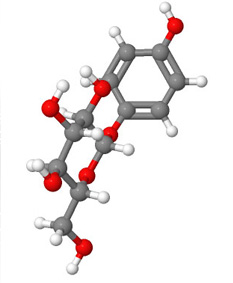







Abrutin molecule
Introduction
Arbutin, (hydroquinone-O-beta-D-glucopyranoside) a naturally occurring -d-glucopyranoside derivative of hydroquinone. The hydroquinone glucoside is a botanically derived compound found in certain plant species, such as bearberry, cranberries, blueberries, wheat, pears and the fresh fruit of the California buckeye, Aesculus californica. The active component, hydroquinone, is released by the hydrolysis of the glucoside fraction. As it is released slowly, the use of arbutin may be less irritating than using hydroquinone directly. The mild effect of arbutin is attributed to the controlled release of hydroquinone as a result of in-vivo cleavage of the glycosidic bond. Arbutin is present in 2 forms, namely alpha and beta-arbutin. It appears that alpha-arbutin offers higher stability and efficacy compared to the beta form.
Mode of action
Arbutin exerted its effect through a controlled release of hydroquinone by the in vivo hydrolysis of the glycosidic bond. It is reported by various researchers to inhibit the oxidation of L-DOPA catalysed by mushroom tyrosinase. A recent study indicated that arbutin inhibits melanin synthesis by inhibition of tyrosinase activity. This appears to be due to the inhibition of melanosomal tyrosinase activity and Pmel-17 protein at noncytotoxic concentrations rather than the suppression of this enzyme’s synthesis and expression. It also inhibits the maturation of melanosomes, possibly by its reported influence on DHICA (5,6-dihydroxyindole-2-carboxylic acid) polymerase activity. It is thought that the activity of arbutin is driven by the structural homologies that it shares with the substrate tyrosine. It was showed that arbutin inhibits the oxidation of L-tyrosine (monophenolase activity) catalysed by mushroom tyrosinase and that it competes for active binding sites in tyrosinase without influencing the mRNA transcription of tyrosinase or being oxidized. However, arbutin itself was oxidized as a monophenol substrate at an extremely slow rate, and the oxidation was accelerated as soon as catalytic amounts (0.01 mM) of l-3,4- dihydroxyphenylalanine (L-DOPA) became available as a cofactor.
Types of arbutin
To increase the efficiency, á-glucosides of arbutin had been chemically synthesized because they hydrolyze more easily to release hydroquinone by á-glycosidases in cells. Synthetic forms of arbutin, alpha-arbutin and deoxyarbutin, exhibit greater ability to inhibit tyrosinase than the naturally occurring compound.
Studies have shown that α-arbutin (4-hydroxyphenyl -glucopyranoside) demonstrates an even stronger inhibitory effect on human tyrosinase activity than arbutin itself. This effect was achieved without affecting mRNA expression of enzyme in cultured human melanoma cells and a three-dimensional human skin model. α-Arbutin has widely replaced arbutin as the chosen skin-lightening agent in topical skin preparations because it is more effective and stable in producing the desired effects on human skin.
Deoxyarbutin (dA), a synthetic form of arbutin synthesized without the hydroxyl moiety, provides a promising treatment for reducing skin hyperpigmentation. dA shows reversible inhibition of tyrosinase activity with associated skin lightening in both a hairless guinea pig model system and in human skin. In a human clinical trial, topical treatment with dA for 12 weeks resulted in a significant or a slight reduction in overall skin lightness and improvement of solar lentigines in a population of light-skinned individuals but there was no significant clinical response in the subset of dark-skinned patients. The reversibility of dA’s impact on skin pigmentation suggests that the compound does not permanently destroy melanocytes. In addition to the reported efficacy, it has been found that dA is less cytotoxic/cytostatic than HQ in treatment of cultured human melanocytes. It has also been reported that dA and associated second-generation derivatives, dose-dependently inhibit tyrosinase hydroxylation and DOPAoxidase activity of tyrosinase. This may be attributed to the chemical structure of dA, as the deoxysugars may increase skin penetration and binding affinity for tyrosinase.
Higher concentrations of arbutin are more efficacious than lower concentrations, but may cause paradoxical hyperpigmentation. Despite the safety of arbutin as an agent to lighten skin, some reports failed to confirm its effect in clinical trials.
>
>
>
>
>
>
>
>
>
>
>
>
>
>
>
>
>
>
>
>
>
>
>
>
>
>
>
>
>
>
>
>
>
>
>
>
>
>
>
>
>
>
>
>
>
>
>
>
>
>
>
TOP 20
Hydroquinone
Monobenzyl Ether of Hydroquinone
Azelaic Acid
Kojic Acid
Arbutin
Retinoids
Mequinol
Niacinamide
Soy
Vitamin C
Corticosteroids
Licorice
Hydroxystilbene
Aloesin
Glutathione
Glycolic Acid
N Acetyl Glucosamine
Gentisic Acid
Green Tea
Melatonin
SKIN WHITENING AGENTS A-Z
a-Hydroxyacids
Aloesin
Alpha Tocopherol and Alpha Tocopherol Ferulate
Arbutin
Azelaic Acid
Centaureidin and Methylophiopogonanone B
Gallic Acid and Derivatives
Gingko
Ginseng
Glutathione
Glycolic Acid
Green Tea
Hesperidin
Hydroquinone
Hydroxycinnamic Acid and Derivatives
Hydroxystilbene
Kojic Acid
Licorice
Linoleic Acid
Magnesium Ascorbyl Phosphate
Melatonin
Mequinol
Monobenzyl Ether of Hydroquinone
Mulberry
N Acetyl Glucosamine
N-Acetyl-4-S-Cysteminylphenol
Niacinamide
Retinoids
Salicylic Acid
Soy
Vitamin C

<< Previous: Alpha Tocopherol
Next: Azelaic Acid >>